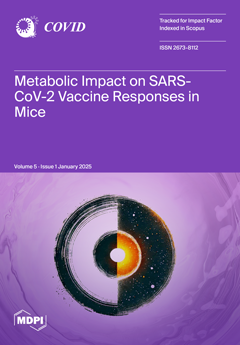Background: COVID-19 infection can have a protracted course in many survivors, with varied sociodemographic and medical characteristics, exhibiting a plethora of symptoms that have consequential impacts on their quality of life. This study sought to gather pertinent data about the prevalence of Long-Haul
[...] Read more.
Background: COVID-19 infection can have a protracted course in many survivors, with varied sociodemographic and medical characteristics, exhibiting a plethora of symptoms that have consequential impacts on their quality of life. This study sought to gather pertinent data about the prevalence of Long-Haul COVID (LC), the predisposing factors to this condition and the burden on the quality of life of Mauritian survivors.
Research Setting: A cross-sectional study was performed using an adapted online questionnaire, using two definitions of Long COVID, namely the WHO and NICE, SIGN and RCGP definitions. Associations between LC and categorical variables were employed to explore relationships between LC and ratio (FAS, FSS, PCS-12, MCS-12) variables. Simple and multivariable logistic regression models were used to assess the predictors and outcomes associated with LC.
Findings: Of 285 Mauritians with a confirmed history of COVID-19 infection, 64.2% developed Long COVID (WHO LC-38.9%, NICE, SIGN and RCGP LC-55.8%). The most prevalent symptoms were fatigue or muscle weakness (88.0%), cough (57.4%), difficulty concentrating (55.2%), trouble remembering or memorising (49.7%), insomnia or sleep disturbance (43.7%), amongst others. Statistically significant associations were determined between LC and age, gender, vaccination status, severity of acute illness, reinfections, self-perception of disease and having more than five acute symptoms. Long COVID positively correlated with fatigue. Both Long COVID and severe fatigue (F = 73.266,
p < 0.001) negatively impacted PCS-12. Fatigue had no significant impact on MCS-12.
Conclusions: This study demonstrated the presence of Long COVID in the Mauritian population. Long COVID manifests as a complex and long-lasting affliction that affects even young adults with disabling outcomes, owing to multiple lingering symptoms but, most importantly, fatigue. The latter brings about distressing declines in physical and overall quality of life that thump both individual and societal health and productivity.
Full article





